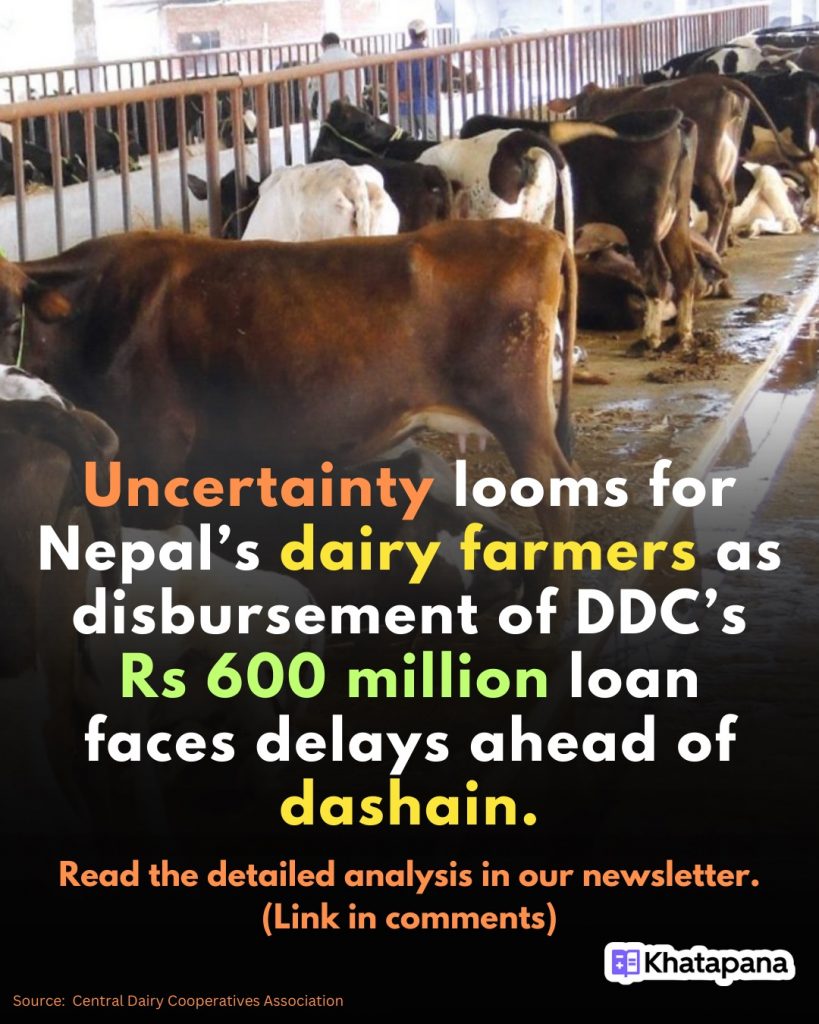
As Dashain — Nepal’s biggest festival — approaches, dairy farmers across the country are biting their nails. While most Nepalis are gearing up for celebrations, this Dashain may turn out to be a sour one for the dairy farmers in Nepal. And mind it, this is not due to the recent heavy rains and disasters. A long overdue of payments from the state-owned Dairy Development Corporation (DDC) is to blame for.
The good news is: DDC has managed a whopping Rs 600 million from the Government in credit to settle their bills. But the dairy farmers across the country are still uncertain about receiving these payments in time for Dashain. With the festival just around the corner, the big question remains: Will the farmers actually get paid in time?
Let’s dive into what’s going on here and why farmers are still so skeptical.
Agricultural Sector’s Contribution to the Nepalese Economy
Agriculture still stands as the backbone of Nepal’s economy, with 24 percent contribution being made to the country’s GDP. Furthermore, the agricultural sector has also been generating employment opportunities for over half the population. A whopping 62% of the population is engaged in agriculture. Within this sector, dairy farming has been playing a significant role, accounting for 8 percent of the agricultural GDP.
However, this crucial sector is faced with a severe crisis, as dairy farmers across the country have been left awaiting their long deserved dues worth around Rs. 6.5 billion. As of September 2024, DDC owes farmers approximately Rs. 2.5 billion. This is part of a larger unpaid amount across the country, which totals around Rs. 6.5 billion, with other private dairy companies contributing to the staggering dues. As per Mr. Bal Krishna Uprety— the treasurer of Central Dairy Cooperatives Association, these payments have been pending since November of 2023.
What’s Happening With the Rs 600 Million Loan?
You’d think Rs 600 million is more than enough to get farmers paid, right? Well, that’s what the government hoped when they handed over the money to DDC. The idea was simple: DDC gets the loan, and dairy farmers finally receive their long-overdue payments for the milk they’ve been providing. Easy, right?
Not quite. Even after receiving the funds, farmers are still waiting, and their patience is wearing thin. Dashain is a time for family, celebrations, and, well, spending money. For farmers who work tirelessly every day, this delay feels like a slap in the face. And the Rs 600 million is only a quarter of the total dues. So, getting full payment still looks like a long battle for the farmers and the dairy industry is already on the brink of crisis.
What’s Causing the Delay?
So, why the hold-up? Well, DDC isn’t exactly known for being quick on its feet. Like many government-affiliated companies, it’s bogged down by endless layers of bureaucracy. Picture stacks of paperwork, approval after approval, and then more approvals — all just to get the funds moving.
And if that wasn’t bad enough, DDC owes money to a bunch of other people too, like suppliers and creditors. So even though they’ve got the Rs 600 million, farmers are worried that paying them might not be at the top of DDC’s to-do list. Adding to the drama is the fact that DDC hasn’t been the best at communicating their payment timeline, leaving farmers in the dark.
Oh, and here’s the kicker: this isn’t the first time farmers have been left hanging around Dashain. History has taught them to expect delays, and they’re not optimistic things will be any different this time.
Why This Delay is a Major Concern for Farmers
For most dairy farmers, their livelihood depends on a steady stream of payments. These aren’t wealthy landowners who can wait months for their checks — they need this money to put food on the table, take care of their cattle, and, of course, celebrate Dashain with their families.
Missing out on these payments before the festival means they might have to take out loans or cut back on essentials. For a lot of families, this is more than just an inconvenience — it’s a real financial crisis. Imagine working hard every day and still worrying if you’ll have enough to cover your basic expenses. That’s the reality for many farmers right now.
And it’s not just about their immediate income. If they can’t afford to buy feed for their cows or make necessary investments in their farms, milk production could drop, impacting their future income as well. To top it all off, banks might hesitate to lend them money if they think payments from DDC aren’t reliable.
DDC’s Current Challenges
You’d think with all that cash in hand, DDC would have no problem paying farmers by now. But the truth is, DDC has been struggling financially for years. As a government-owned company, it faces stiff competition from private dairy firms that can pay farmers faster and offer better deals.
Now, with Rs 600 million burning a hole in their pocket, DDC’s management is under pressure to make sure the money goes where it’s supposed to. But how well are they handling it? Many experts and farmers are concerned that the company’s long-standing inefficiencies will only drag this process out further.
If DDC can’t get its act together, this won’t just be a one-time problem. The company’s reputation is already shaky, and mishandling this situation could make things even worse for both farmers and the entire dairy industry in Nepal.
The Broader Dairy Industry: Room for Reform
This isn’t just a DDC problem — it’s a wake-up call for Nepal’s entire dairy sector. Even though the country produces millions of liters of milk every year, the way it’s distributed, priced, and paid for is, let’s face it, pretty messy.
Many experts are calling for serious reforms to make sure farmers don’t keep getting the short end of the stick. Here’s what they’re suggesting:
- Digitize payments: If payments were handled electronically, farmers wouldn’t have to wait as long or deal with unclear payment schedules.
- Fix DDC’s finances: It’s about time DDC stopped drowning in bureaucratic red tape and started using funds like the Rs 600 million credit to actually pay farmers on time.
- Let private companies compete: Opening up the market to more private players could drive competition, which would ultimately benefit both farmers and consumers.
If these changes aren’t made, Nepal’s dairy industry could see bigger problems down the road.
So, What’s Next for the Farmers?
With Dashain coming up fast, dairy farmers in Nepal are hoping for a miracle. They’re holding out hope that the Rs 600 million will make it to their accounts in time for the festival. But after years of delays and empty promises, most of them are preparing for the worst.
Unless DDC and the government step up and take action quickly, this situation could leave a sour taste for more than just the farmers. It could damage trust in Nepal’s dairy sector as a whole. For now, farmers are left waiting — and worrying — with each passing day.
You can now read the most important #news on #eDairyNews #Whatsapp channels!!!
🇮🇳 eDairy News ÍNDIA: https://whatsapp.com/channel/0029VaPidCcGpLHImBQk6x1F

















